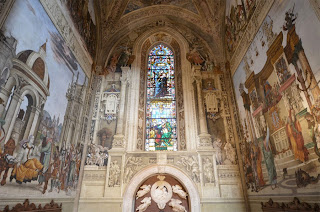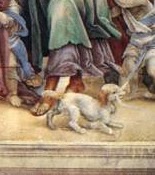We begin our journey into Fillipino Lippi's frescoes in the Strozzi Chapel by entering the beautiful, pietro serena Santa Maria Novella in Florence.
Santa Maria Novella, Leon Battista Alberti, 1470
We respectfully work our way up to the altar where, just to it's right, we are drawn to the vibrant, animated frescoes of the Strozzi Chapel.
Here, boldly painted, are four Old Testament patriarchs: Adam, the most visible over the altar, Noah, reclining to the West above Saint John the Evangelist, Abraham, opposite and above Saint Phillip, and, finally, Jacob, hidden from the outside and above the chapel entrance. Patriarch is Greek for leader or first among fathers. We will see why these four were chosen as a part of the decoration theme of the chapel. The boarders that separate the four, as J. Russell Sale describes in his dissertation, Lippi's Strozzi Chapel, are a framework of interlocked, stylized volutes containing a series of repeated palmettes, leaf-masked male heads, and the three-Strozzi crescents."

Adam, Noah, and Abraham are illuminated from a stained-glass window below. Jacob received light from above and to the left. Three of the four prophets are in contapposto position and fit the triangular frame in which they are painted. Prior to this time, prophets were mostly painted in a frontal position. Filippino's father, Fra Filippo Lippi, may have been a precursor to Fillipino's break from tradition in his frescoes of the prophets Mark and Matthew in the main chapel at the Prato cathedral. Below, is a short, yet awe-inspiring, video of the fresco program in that duomo:
Filippino Lippi surpassed his father in this new approach with a more intense and dramatic depiction of prophets. He has, now, seated contrapposto poses to enhance the drama of a scene. We saw this with his Carafa sibyls in Rome, especially the Tiburtine and Cumean sibyls. The choice of Adam, Abraham, Noah, and Jacob was unusual but we will see that they have a woven thread of consistency in the fresco program with the theme of death and resurrection in Filippo Strozzi's final, mortal resting place - his burial chapel.
Noah and Abraham are painted above the narrative scenes on the side walls and are inclined towards the altar. Adam is upright and ties in with the vertical expressions in the decoration below. Between Noah and Abraham, and out of chronological order, is Jacob. He, also, is painted upright. These Old Testament prophets represent the first saved souls in heaven as we see described in the New Testament:
I tell you, many will come from east and west and sit at the table with Abraham, Isaac, and Jacob in the kingdom of heaven. (Matthew 8:11)
The poor man died and was carried by angels to Abraham's bosom. The rich man also died and was buried; and in Hades, being in torment, he lifted up his eyes, and saw Abraham far off and Lazarus in his bosom. (Luke 16:22-23)
The energetic Noah represents divine intervention as he was saved from the flood by God.
And God blessed Noah and his sons, and said to them, "Be fruitful and multiply, and fill the earth." (Genesis 9:1)
This begins our theme that ultimately honors Filippo Strozzi as head of the family. Another depiction of God's intervention is in the fresco directly across from Noah, and above the depiction of the life of Saint Phillip. This is Abraham, whose son, Isaac, was delivered from death by Abraham. Like God the Father, Abraham was willing to sacrifice his own son as an instrument of faith.
Through Isaac, we have a prefiguration of the passion of Christ and Abraham reminds us of this as he glances down at the altar in the chapel where the Eucharist is celebrated. We see a sacrificial lamb representing the Lamb of God. Filippo Strozzi's
impresa includes a recumbent lamb which is painted in the window below and on the keystone in the arch above, again connecting him to the decorative theme.
Jacob, who is not depicted in chronological order, is above the entry portal. He has a book in his left hand and a vessel in his right hand. We can read, "Hec est domus dei et porta (cae)le
" translated as
"This is the house of God and the gate of heaven" (Genesis 28:17).
Like Noah (grapes) and Abraham (lamb), Jacob also represents the figure of Christ with the vessel. The vessel in his right hand holds oil to anoint the stone (altar). Jacob has a vision of a ladder extending to heaven and representing the ascent to heaven and the quest for divine wisdom. The gates of heaven theme coincide with the portal entrance to the chapel and, therefore, are the reason that Jacob is not in chronological order.
Adam is the first patriarch and the first divinely-created man. He can easily be seen above the altar wall and above the Strozzi tomb. He is frontally depicted with his legs turned slightly to the left.

He supports a hoe and wears a pelt, showing us his humanity. He is gazing towards the female-headed serpent. There is a dried out fig tree and a small, frightened child. This is not a biblical narrative but shows life after the expulsion from the Garden of Eden. As we know, Adam disobeyed God and was punished, as were all man, through original sin. In Adam's face we see the sadness of his tragic fate. The glare over his shoulder is the symbol of temptation. The twists and turns of his body remind us of his internal unrest. We are all attracted to the serpent who represents Eve and "man's seduction away from God and the spirit by sensual pleasure." (Ambrose-Sale p.197) As with our other patriarchs, Adam is a direct prototype for Christ. It is believed that the small child is Adam's son, Seth.
All of our prophets are without halos but, rather, have rays of light on their faces. This ties us back to the Strozzi three crescent moons which represent family unity, strength, and concern for one another. They represent the goddess Luna and covey her heavenly fertility.






















































